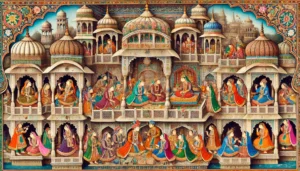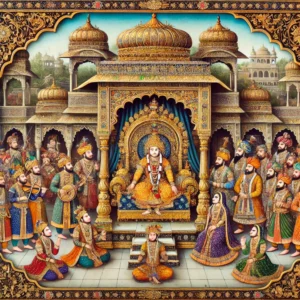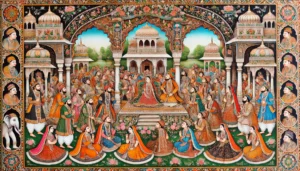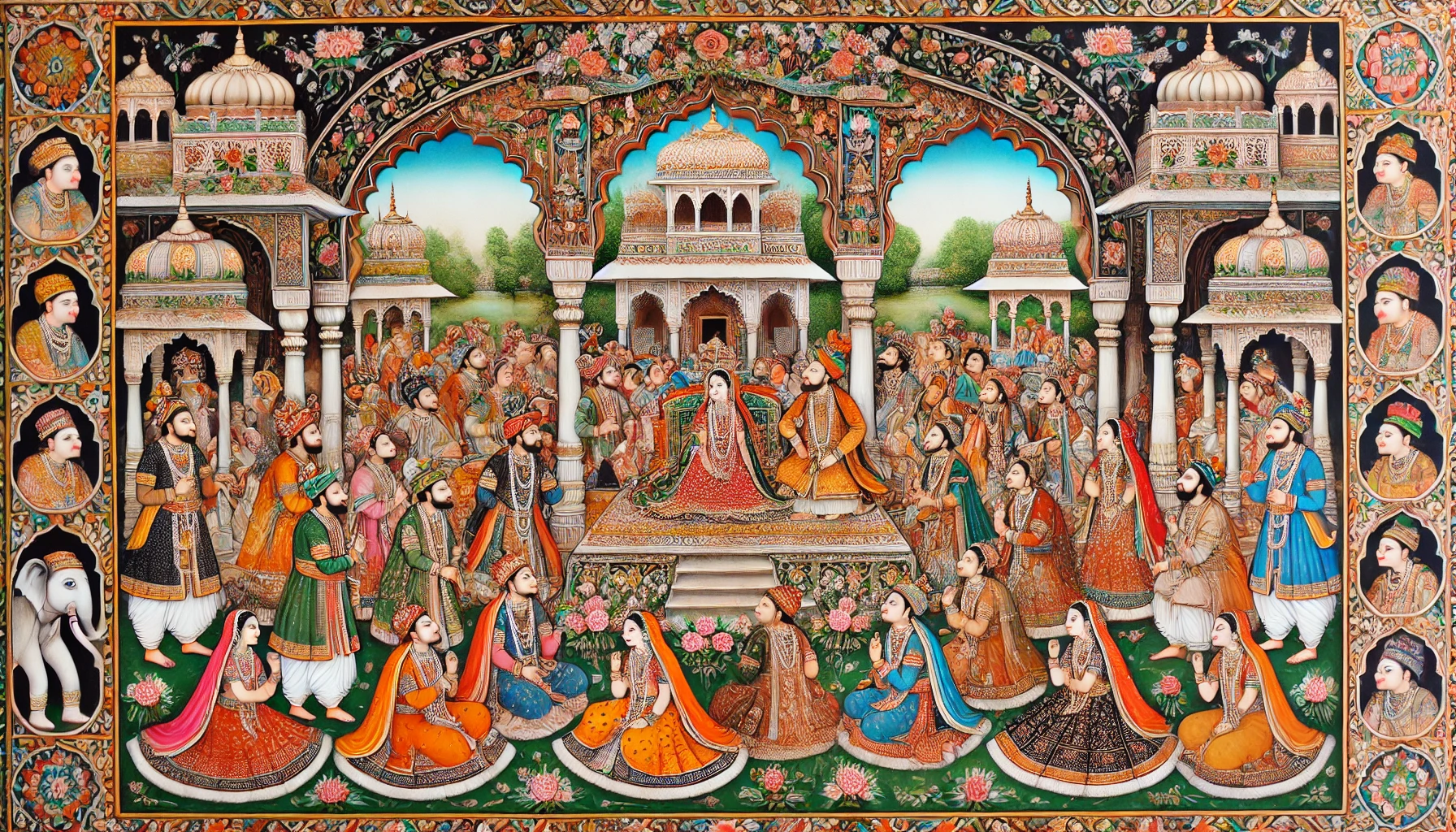
History of Indian miniature paintings
Miniature Paintings: A Peek into India’s Aesthetic Legacy
Art has always been an intrinsic part of India’s cultural fabric, reflecting its history, traditions, and diverse influences. Among the many artistic traditions that have flourished on Indian soil, miniature paintings hold a special place. These tiny yet incredibly detailed artworks are not just aesthetic wonders but also historical records that capture the socio-cultural and political essence of their times. Miniature paintings, known for their intricate brushwork, vibrant colors, and narrative depth, have evolved over centuries, absorbing influences from different dynasties and regions.
This article explores the history, major schools, techniques, and lasting impact of Indian miniature paintings, offering a deeper understanding of their artistic and cultural significance.
The Origins of Miniature Paintings
The tradition of miniature painting in India can be traced back to the 7th century during the Pala dynasty in eastern India. Early miniatures were found in Buddhist manuscripts, painted on palm leaves with natural dyes. These paintings primarily depicted Buddhist themes, including scenes from the Jataka tales and representations of the Buddha.
By the 12th century, Jainism had also embraced the art form, with miniature paintings adorning Jain texts. The use of brighter colors, elaborate borders, and geometric patterns became prominent features of Jain miniature paintings. However, the art form saw its most significant development during the medieval period, particularly under the Mughal, Rajput, and Deccan courts.
The evolution of miniature paintings in India was not isolated—it absorbed Persian, Central Asian, and European influences, blending them with indigenous techniques to create a unique visual language.
Table of Contents

History of Indian miniature paintings
Major Schools of Miniature Paintings in India
Over the centuries, different regions and ruling dynasties nurtured and refined the miniature painting tradition. The result was the emergence of distinct schools, each with its unique style, themes, and color palettes.
- Pala School (8th-12th Century)
The Pala school, one of the earliest forms of miniature painting in India, developed in the Buddhist monasteries of Bengal and Bihar. These paintings were characterized by delicate lines, soft natural colors, and spiritual themes. Figures were often depicted with elongated eyes, slender forms, and calm expressions, reflecting the Buddhist ideals of serenity and detachment.
- Western Indian and Jain School (12th-16th Century)
With the rise of Jainism, miniature paintings found a new medium—religious manuscripts. Jain miniatures were typically created on palm leaves and later on paper. They featured bold colors like red, blue, and gold, with intricate detailing and a distinctive lack of perspective, making the compositions appear flat. Figures had exaggerated facial features, with prominent eyes and stiff postures.
- Mughal School (16th-18th Century)
One of the most celebrated schools, the Mughal miniature painting style developed under Emperor Akbar and continued to flourish under Jahangir and Shah Jahan. Persian influences, brought by artists from Iran, merged with Indian themes, creating highly detailed, naturalistic compositions.
Mughal miniatures focused on courtly life, royal portraits, historical events, hunting scenes, and natural elements like flora and fauna. The use of perspective, shading, and minute details set these paintings apart. Notable Mughal painters included Basawan, Daswanth, and Abul Hasan.
- Rajput School (17th-19th Century)
Unlike the Mughal school, which was more secular, the Rajput style was deeply rooted in Hindu traditions and mythology. Rajput miniature paintings developed in the princely states of Rajasthan and included several sub-schools, such as:
- Mewar School – Known for its bright colors and bold lines, often depicting Krishna’s life and royal processions.
- Marwar School – Focused on courtly grandeur and warrior traditions.
- Bundi & Kota Schools – Inspired by nature, with lush landscapes and scenes from Ragamala paintings (depictions of musical moods).
- Bikaner School – Showed Mughal influence, with refined detailing and Persian-style compositions.
Themes in Rajput miniatures included episodes from the Ramayana, Mahabharata, Radha-Krishna legends, and scenes of love and devotion.
- Deccan School (16th-19th Century)
Developed under the patronage of the Deccan Sultanates (Bijapur, Golconda, Ahmadnagar), this style exhibited a blend of Persian, Turkish, and local Indian influences. Deccan miniatures are known for their rich jewel tones, use of gold, and stylized human figures with elongated features. They often depicted courtly life, poetry, and allegorical themes.
- Pahari School (17th-19th Century)
Originating in the hilly regions of Himachal Pradesh, Punjab, and Jammu, the Pahari school had several substyles, including:
- Basohli School – Famous for its bold lines, bright colors, and expressive faces.
- Kangra School – Known for its soft, naturalistic style, with delicate figures and romantic themes, particularly Radha-Krishna love stories.
- Guler School – More refined and sophisticated, with European-influenced shading techniques.
Pahari miniatures often illustrated Hindu epics, Bhakti poetry, and nature-inspired themes.
Techniques and Materials Used
Creating a miniature painting requires extraordinary skill and patience. The process involves:
- Handmade Paper or Cloth – Traditional artists used paper treated with starch and polished with stones for a smooth surface.
- Natural Pigments – Colors were derived from minerals (lapis lazuli for blue, red ochre for red), vegetables, and even precious metals like gold and silver.
- Fine Brushes – Brushes were made from squirrel hair or bird feathers to ensure precision.
- Multiple Layers – Colors were applied in several layers, often followed by intricate detailing using a single-hair brush.
- Burnishing – The final artwork was polished with agate stones to enhance its sheen.

History of Indian miniature paintings
Cultural and Historical Significance
Miniature paintings were not just decorative art; they played a vital role in preserving historical events, religious beliefs, and literary traditions. These paintings adorned:
- Royal Manuscripts – Chronicles of emperors, court scenes, and historical battles.
- Temple Artworks – Depictions of Hindu deities, epics, and devotional themes.
- Love & Poetry Collections – Romantic ballads and Persian-influenced poetry.
- Ragamala Series – Visual interpretations of musical compositions.
Miniature paintings provided a medium for storytelling, allowing generations to engage with mythology, history, and artistic expression.
The Revival and Modern Influence
While the decline of royal patronage in the 19th century led to a slowdown in traditional miniature painting, efforts to revive the art form have been successful. Government initiatives, art institutions, and contemporary artists have rekindled interest in this intricate tradition.
Today, miniature painting techniques are used in textiles, jewelry, and modern art forms, blending traditional skills with contemporary themes. Museums and exhibitions worldwide showcase Indian miniatures, ensuring their legacy remains alive.
Conclusion
Miniature paintings are a magnificent testament to India’s artistic brilliance and cultural heritage. Their intricate craftsmanship, vibrant colors, and deep storytelling make them invaluable to art lovers and historians alike. As this tradition continues to inspire contemporary artists, miniature paintings remain a cherished link to India’s rich past, blending history, mythology, and aesthetics into a timeless artistic expression.
FAQs on Miniature Paintings: Unveiling India’s Timeless Artistic Heritage
- What are miniature paintings?
Miniature paintings are small, highly detailed artworks created on various surfaces like paper, cloth, or ivory. They often depict historical events, mythological stories, court life, and nature.
- When did miniature painting flourish in India?
Miniature painting in India flourished between the 10th and 18th centuries, reaching its peak during the Mughal, Rajput, Pahari, and Deccan schools of art.
- What are the main styles of Indian miniature paintings?
The prominent styles include:
Mughal Miniatures – Refined, Persian-influenced, and realistic.
Rajput Miniatures – Bold colors, Hindu themes, and romantic depictions.
Pahari Miniatures – Soft color tones and lyrical themes.
Deccan Miniatures – Vibrant, Persian-Arab influences, and intricate designs.
- What materials were traditionally used in miniature paintings?
Artists used natural pigments derived from minerals, plants, and gold or silver. Fine brushes made from animal hair were used for intricate detailing.
- What themes are commonly depicted in Indian miniature paintings?
Themes range from religious epics (Ramayana, Mahabharata), royal court scenes, romantic tales, folklore, and nature-inspired compositions.
- How do miniature paintings differ from other Indian art forms?
Unlike large-scale murals, miniature paintings are known for their detailed precision, storytelling elements, and intricate brushwork on small canvases.
- Are miniature paintings still made today?
Yes, many artists continue this traditional art form, often blending it with contemporary themes while preserving classical techniques.
- Where can one see authentic miniature paintings in India?
Authentic collections can be found in museums like:
National Museum, Delhi
City Palace Museum, Jaipur
Chhatrapati Shivaji Maharaj Vastu Sangrahalaya, Mumbai
Mehrangarh Fort Museum, Jodhpur
- How can one differentiate between an original and a replica miniature painting?
Originals have fine detailing, natural pigments, and visible brush strokes, while replicas may lack depth, have synthetic colors, and lack traditional textures.
- Can miniature paintings be purchased today?
Yes, many art galleries and online platforms sell authentic and contemporary miniature paintings. However, buyers should verify authenticity before purchasing.
Summary
Miniature paintings are a revered art form in India, known for their intricate detailing, rich color palettes, and historical significance. These exquisite artworks trace their origins to the 6th and 7th centuries, flourishing under royal patronage from the Mughal, Rajput, Pahari, and Deccan courts. Unlike large-scale murals, miniature paintings are created on smaller surfaces such as palm leaves, paper, cloth, and ivory, requiring masterful precision and extraordinary craftsmanship.
Each regional school of miniature painting developed a distinct style, reflecting the cultural, religious, and political influences of its time. The Mughal school, influenced by Persian and Central Asian traditions, introduced naturalism, depth, and intricate shading, often portraying royal court life, hunting scenes, and historical narratives. The Rajasthani school, divided into sub-schools like Mewar, Marwar, Bundi, and Kishangarh, showcased bold colors, expressive emotions, and mythological themes inspired by Hindu epics like the Ramayana and Mahabharata.
The Pahari school, emerging in the serene Himalayan regions, embraced lyrical beauty, softer tones, and delicate brushwork, often depicting Radha-Krishna themes with an ethereal charm. Meanwhile, the Deccan school, enriched by Persian, Turkish, and indigenous influences, emphasized vibrant hues, dynamic compositions, and intricate geometric patterns.
Miniature paintings were not just visual delights but also served as historical records, illustrating royal chronicles, religious manuscripts, and daily life. The art flourished through handwritten manuscripts, such as the Jain Kalpasutra, the Baburnama, and the Ragmala series, which combined poetry and visual storytelling.
However, with the advent of colonial rule and industrialization, traditional patronage declined, leading to a temporary decline of the miniature painting tradition. Yet, dedicated artists and institutions played a crucial role in preserving and reviving this heritage. Today, miniature paintings are celebrated globally, with contemporary artists blending traditional techniques with modern themes, ensuring that this art form continues to thrive.
Despite its evolution over centuries, miniature painting remains a testament to India’s artistic legacy, symbolizing the country’s deep-rooted cultural identity, exquisite craftsmanship, and timeless storytelling traditions.
Unlock the Ancient Wisdom of Sanatan Dharma – Join Us on YouTube!
👉 Subscribe now to Prachin Sanatan Dharma and embark on a journey of enlightenment.
Explore timeless teachings, spiritual insights, and cultural richness on our YouTube channel, Prachin Sanatan Dharma. Dive deep into the essence of Sanatan Dharma through captivating videos that inspire and educate.
Related Articles
- Restful Nights: Ayurvedic Remedies and Traditional Indian Practices to Overcome Insomnia and Late-Night Habits
- The Tridevi: Lakshmi, Saraswati, and Parvati – Their Roles and Powers
- “Divine Creatures of Ancient Indian Scriptures: Exploring the Role of Animals in the Vedas, Puranas, and Mahabharata”
- Nature and Spirituality: Exploring the Sacred Essence of the Himalayas, Ganga, and Other Natural Wonders”
- “Reviving the Gurukul System: Relevance and Lessons for Modern Education”
- “Exploring Greek and Indian Mythology: Similarities Between Greek and Indian Mythology “
- “Embracing Sattvic Living: Harmonizing Mind, Body, and Soul Through Food and Lifestyle”
- “Charity and Prosperity: Exploring the Concept of Daan and Its Financial Relevance in Modern Life”
- How to Build an Eco-Friendly Home Inspired by Vastu Shastra
- Comparison of Ancient and Modern Sports: How Traditional Sports Have Influenced Contemporary Games
- “Timeless Lessons from Ancient Tales: Linking Samudra Manthan and Ganga’s Descent to Modern Ecological Challenges”
- “Reviving Sanskrit: How AI is Preserving Ancient Languages for the Future”
- “Mathura: The Sacred Land of Lord Krishna’s Divine Leelas”
- Investing for Future Generations: Lessons from Indian Traditions on Legacy Building and Wealth Preservation
- “Ancient Indian Wisdom: Timeless Lessons for Tackling Today’s Climate Crisis”
- “Artificial Intelligence and Spirituality: Transforming Ancient Practices for the Modern World”
- “Gold and Real Estate in India: Timeless Assets Shaping Financial Strategies”
- Tradition Meets Innovation: The Evolution of Technology in Hindu Rituals
- End-of-World Myths: Exploring Kali Yuga in Hinduism and Ragnarök in Norse Mythology
- Garuda, Pegasus, and Dragons: The Universal Ties of Mythical Beasts Across Cultures
- “Ancient Vimanas: Mythical Flying Machines or Evidence of Advanced Technology?”
- Time Travel in Hindu Mythology: The Fascinating Tales of Kakudmi and King Raivata
- “Divine Feminine Power in Hindu Mythology: The Legends of Durga, Saraswati, and Lakshmi”
- “Divine Beings of Sanatan Dharma: The Spiritual Significance of Sacred Animals in Hinduism”
- “Symbolism in Mythological Art: Unlocking Hidden Meanings in Ancient Temple Carvings”
- “Exploring Technological Advancements in Ancient India and Civilizations: Vimana, Metallurgy, & Water Management systems”
- Unveiling the Mysteries: Ancient Temples of Sanatan Dharma , Mysterious Temples of India
- “The Scientific Knowledge of Sanatan Dharma: Ancient Wisdom Meets Modern Science”
- Ancient Indian Sports and Games: Celebrating a Legacy of Skill, Strength & Strategy”
- “Exploring the Cosmic Link: The Connection Between Astronomy and Vedic Astrology”
- The Power of Sanskrit: Unlocking the Divine Language of the Gods
- “The End of Kaliyuga: A Sanatan Insight into the World’s Final Chapter”
- Explore more articles on Prachin Sanatan Yuga.
History of Indian miniature paintings History of Indian miniature paintings History of Indian miniature paintings History of Indian miniature paintings History of Indian miniature paintings History of Indian miniature paintings History of Indian miniature paintings History of Indian miniature paintings History of Indian miniature paintings History of Indian miniature paintingsbHistory of Indian miniature paintings
History of Indian miniature paintings History of Indian miniature paintings History of Indian miniature paintings History of Indian miniature paintings History of Indian miniature paintings History of Indian miniature paintings History of Indian miniature paintings History of Indian miniature paintings History of Indian miniature paintings History of Indian miniature paintings History of Indian miniature paintings
History of Indian miniature paintings History of Indian miniature paintings History of Indian miniature paintings History of Indian miniature paintings History of Indian miniature paintings History of Indian miniature paintings History of Indian miniature paintings History of Indian miniature paintings History of Indian miniature paintings History of Indian miniature paintings History of Indian miniature paintings
Miniature paintings are a revered art form in India, known for their intricate detailing, rich color palettes, and historical significance. These exquisite artworks trace their origins to the 6th and 7th centuries, flourishing under royal patronage from the Mughal, Rajput, Pahari, and Deccan courts. Unlike large-scale murals, miniature paintings are created on smaller surfaces such as palm leaves, paper, cloth, and ivory, requiring masterful precision and extraordinary craftsmanship.
Miniature paintings are a revered art form in India, known for their intricate detailing, rich color palettes, and historical significance. These exquisite artworks trace their origins to the 6th and 7th centuries, flourishing under royal patronage from the Mughal, Rajput, Pahari, and Deccan courts. Unlike large-scale murals, miniature paintings are created on smaller surfaces such as palm leaves, paper, cloth, and ivory, requiring masterful precision and extraordinary craftsmanship.
